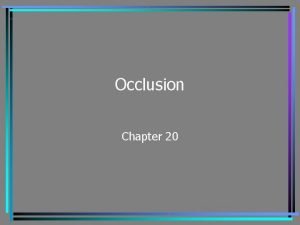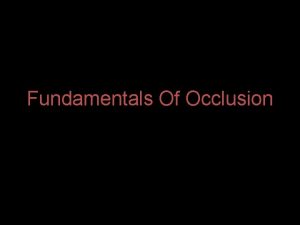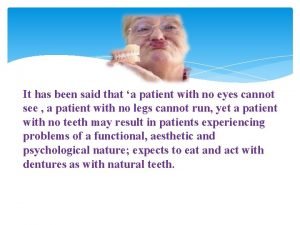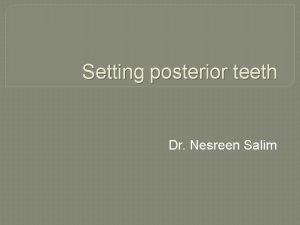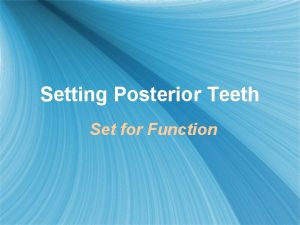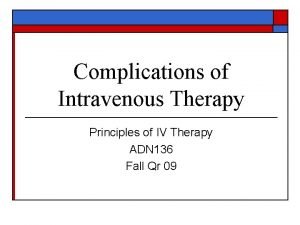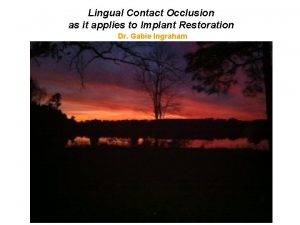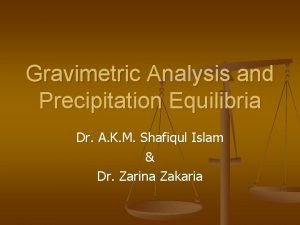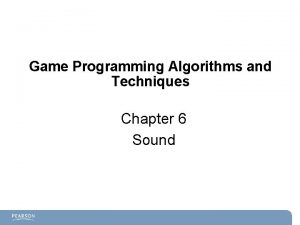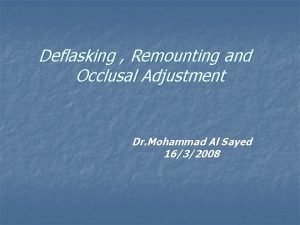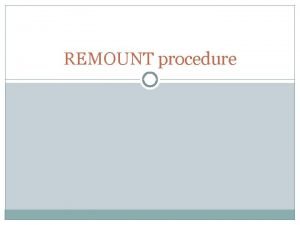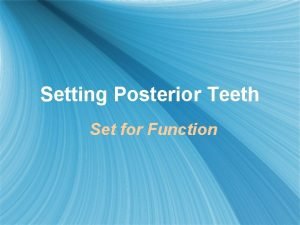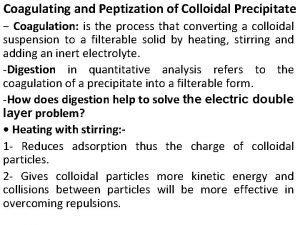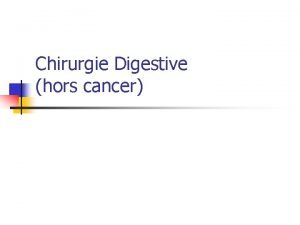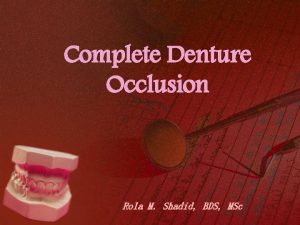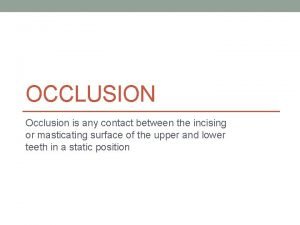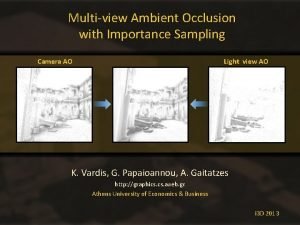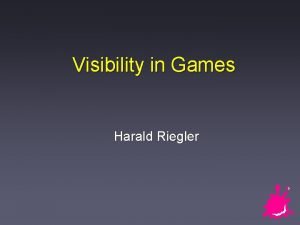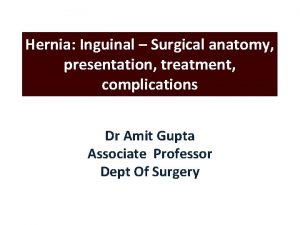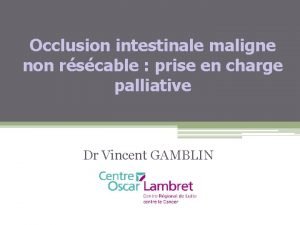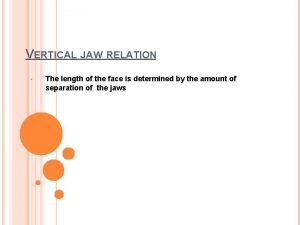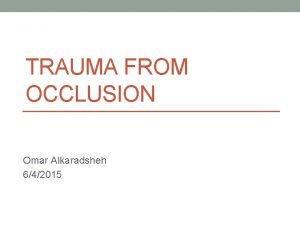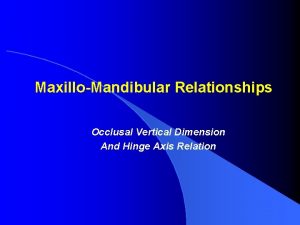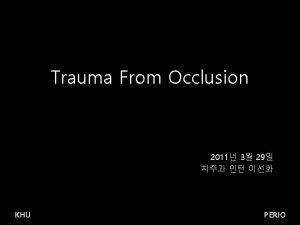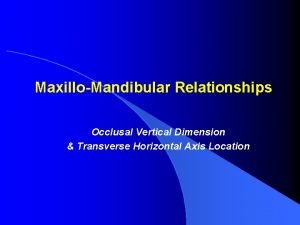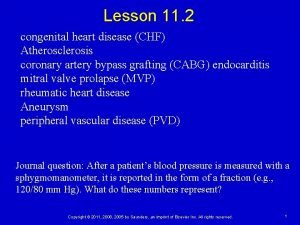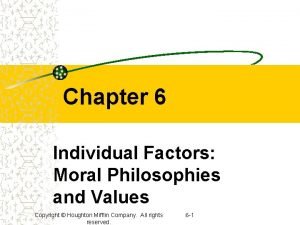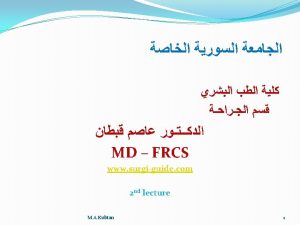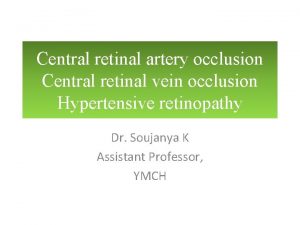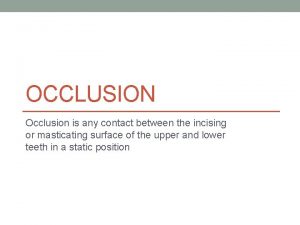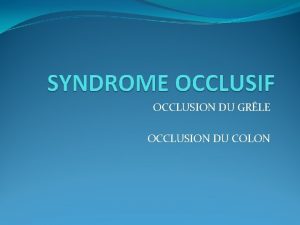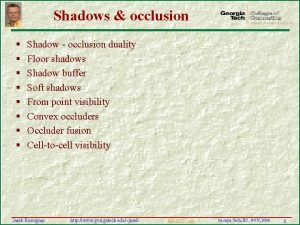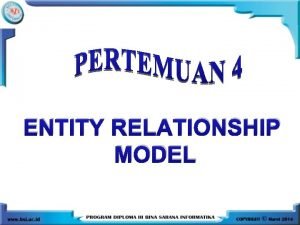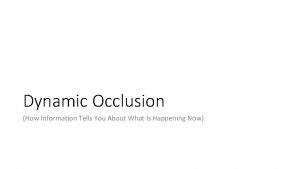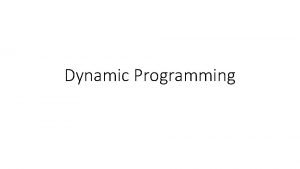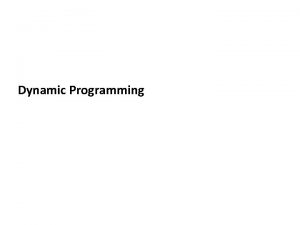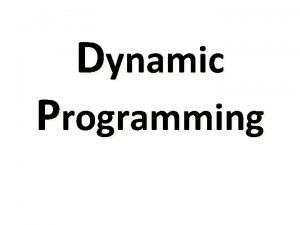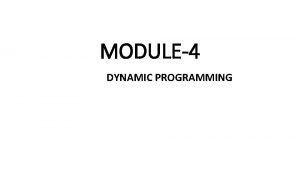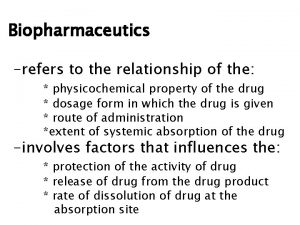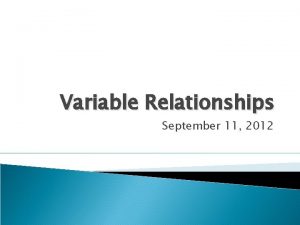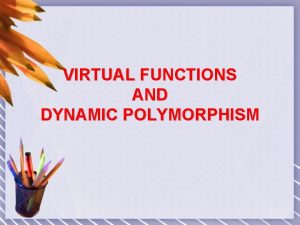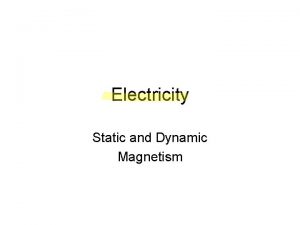OCCLUSION Occlusion refers to a dynamic relationship of








































- Slides: 40

OCCLUSION

• Occlusion refers to a dynamic relationship of the • cusps of teeth in all functional positions of the jaw. It is a complex phenomenon involving the teeth, PDL, the jaws, the TMJ, the muscles and the nervous system. Angle: Normal relation of the occlusal inclined planes of the teeth when the jaws are closed.

• TERMINOLOGIES: • Ideal occlusion: Theoritical concept of occlusal, • • structural and functional relationship that includes idealized principles and characteristics that an occlusion should have. Physiologic occlusion: deviates from ideal, but is well adapted to that particular environment. Balanced occlusion: balanced and equal contacts are maintained through all excursion movements of the mandible.

• Functional occlusion: an arrangement that will • • provide the highest efficiency during all excursive movements of the mandible. Therapeutic occlusion: modified by appropriate therapeutic modalities to change a nonphysiologic occlusion to a physiologic one. Traumatic occlusion: An abnormal occlusal stress capable of producing injury to the periodontium.

• CENTRIC RELATION/TERMINAL HINGE POSITION/LIGAMENTOUS POSITION: It is the relation of the mandible to the maxilla when the mandibular condyles are in the most superior and retruded position in their glenoid fossa with the articular disc properly interposed. At centric relation both the condyles are simultaneously seated most superiorly in the glenoid fossa.

• CENTRIC OCCLUSION/INTERCUSPAL POSITION/CONVENIENCE OCCLUSION: It is that position of the mandibular condyle when the teeth are in maximum intercuspation. Centric relation and centric occlusion should coincide in order to have perfect harmony between the teeth, the tmj and the neuromuscular system.

• ECCENTRIC OCCLUSION: It is the contact of - teeth that occurs during the movement of the mandible. Functional occlusion/ Working side occlusion: refers to the tooth contacts that occur in the segment of the arch towards which the mandible moves. Non-functional/ balancing occlusion: the tooth contacts that occur in the segment away from which mandible moves.

• PERIODS OF OCCLUSAL DEVELOPMENT: 1) PEDENTAL PERIOD: ü Period after birth, lasts for 6 months ü Alveolar processes are called Gum Pads ü Gum pads- pink, firm and covered by fibrous periosteum ü Different grooves- Dental groove, Transverse grooves, Gingival groove, Lateral sulcus. ü Upper gum pad – wider and longer overjet

üContact at the molar region and space in the anterior region infantile open bite suckling üNatal teeth- teeth present at the time of birth ; Neonatal teeth- teeth that erupt during the first month of age

• THE DECIDUOUS DENTITION PERIOD: üPrimary teeth: Initiation- first 6 wks of IU life ; Eruption- 6 months ; Eruption completed- 2 1/2 – 3 1/2 yrs. üFirst teeth to erupt in the oral cavity: Mandibular central incisors

üSequence of eruption: A-B-D-C-E üPrimary dentition is established by 3 yrs and stable btw 3 -6 yrs.

üSpacing btw primary teeth- physiologic/developmental space. üSpacing occurring mesial to maxillary canines and distal to mandibular canines. Primate/ simian spaces. üMesio-distal relation btw the distal surfaces of the upper and lower second primary molars- terminal plane.

üNormal for dec. - Flush terminal plane.

üDeep bite may occur in the initial stages, later reduced by- eruption of deciduous molars, attrition of incisors, forward movement of the mandible. • MIXED DENTITION PERIOD: üBegins at approx 6 yrs of age; eruption of 1 st perm molar.

üClassified into three phases: § First transitional period § Inter transitional period § Second transitional period.

§ FIRST TRANSITIONAL PERIOD: Marked by the emergence of first perm molar and the incisors. 1 st perm molars are guided into the dental arch by distal surface of the 2 nd dec molar. Three types of mesiodistal relation btw the upper and the lower dec molars: 1) Flush terminal plane: The distal surface of the upper and lower molars are in one vertical plane; normal feature.

-For the erupting 1 st permanent molar to be in a class I relationship the lower molar has to move forward by 3 -5 mm, which occurs in two waysthe early and the late shift. -Early shift: early mixed dentition. Eruptive force of perm molar push dec molars forward close primate space.

-Late shift: Late mixed dentition; when dec 2 nd molar exfoliates the perm 1 st molar drifts mesially utilizing the Leeway space. 2) Mesial step terminal plane: The distal surface of the lower 2 nd dec molar is more mesial than the upper. - Occurs due to early forward growth of mandible.

- Perm molar directly erupts into Angle’s class I occlusion. If growth of the mandible continues, it can lead to Angle’s class III. 3) Distal terminal plane: The distal surface of the lower 2 nd dec molar is more distal than the upper. - The erupting perm molar may be in Angle’s class II malocclusion.

v. INCISAL LIABILITY: 1 st transitional period-perm incisors erupt. Perm incisors > dec incisors. This difference between the amount of space needed for the accommodation of the incisors and the space available is called incisal liability. Maxillary arch - 7 mm Mandibular arch- 5 mm - Incisal liability is overcome by the following factors:

a) Utilization of Interdental Spaces seen in Primary dentition. b) Increase in Intercanine Width c) Change in Incisor Inclination § INTER-TRANSITIONAL PERIOD: It is a relatively stable period, no changes occurring. Deciduous molars and canines present btw perm incisors and molars

§ THE SECOND TRANSITIONAL PERIOD: Replacement of dec molars and canines by premolars and perm cuspids. v LEEWAY SPACE: The combined mesiodistal width of the perm canines and premolars is usually less than that of dec canines and molars. The surplus space is called Leeway space of Nance. - Maxilla: 1. 8 mm AND Mandible : 3. 4 mm

• THE PERMANENT DENTITION PERIOD: üBuds of the perm molar formed before birth; rest formed after birth. üPerm incisors develop lingual; premolars develop below the diverging roots of their predecessor. üEruption sequence: Maxillary arch : 6 -1 -2 -4 -3 -5 -7 / 6 -1 -2 -3 -4 -5 -7 Mandibular arch: 6 -1 -2 -3 -4 -5 -7 / 6 -1 -2 -4 -3 -5 -7

FACTORS FOR STUDY OF OCCLUSION 1. 2. 3. 4. 5. Development of occlusion Dental arch form Compensating curvatures of dental arches Angulation of individual teeth in relation to various planes Functional form of teeth at their incisal and occlusal thirds

6. Functional and lingual relations of each tooth 7. 8. 9. in one arch to its antagonists in opposing arch in centric occlusion Occlusal contact and intercusp relations of all teeth of one arch to opposing arch in centric occlusion Occlusal contact and intercusp relations of all teeth during various functional mandibular movements Neurobehavioral aspects of occlusion

Development of occlusion • • • The primary arch form is oval and by 9 months of age width of arch is established for primary and permanent dentitions. Time of eruption is determined by heredity and enviornmental factors. Factors for development of contact relations at the time of eruption Position of tooth germ Presence of permanent teeth Flush terminal plane Leeway space

Dental arch form • Malpositioning of multiple • • teeth may develop irregularities in arch form Ideal ellipse: U-shaped, square arch form and tapered. Arch form of maxilla is larger than mandible leading to maxillary teeth overhanging mandibular teeth- OVERJET

Compensating curvatures of dental arches • Curve of spee: cusps and incisal ridges of teeth display a curved allignment when arches were observed from a point opposite the first molars. • Curve of Wilson: curvature of mandibular teeth is concave and maxillary teeth is convex.

• Curve of Monson: mandibular arch adapted itself to curved segment of a sphere of a 4 -inch radius • Bonwil equilateral triangle: mandibular arch approximates to a 4 -inch equilateral triangle.

Angulation of individual teeth in relation to various planes • Each tooth must be placed at the angle that best withstands the lines of forces brought against it during function. • The angle at which it is placed depends upon the function it has to perform

Functional form of teeth at their incisal and occlusal thirds • When teeth of one jaw comes into occlusal • • contact with their antagonists in opposite jaw during mandibular movements, curved surfaces come into contact with curved surfaces. Sulci and grooves act as escapement spaces for food. Cusps help in establishing teeth in correct position during occlusion.

Functional and lingual relations of each tooth in one arch to its antagonists in opposing arch in centric occlusion • Each tooth of one arch in occlusal with portions with two others in opposing arch with exception of: mandibular central incisors maxillary third molars

Occlusal contact and intercusp relations of all teeth of one arch to opposing arch in centric occlusion • CENTRIC STOP: areas of contact that a supporting cusp • makes with opposing tooth. Mandibular first molar Supporting cusps: lingual cusps of maxillary posterior teeth and buccal cusps of posterior mandibular teeth.

Occlusal contact and intercusp relations of all teeth during various functional mandibular movements • Mandibular movements: • lateral movements lateral protrusive movements retrusive movements Contact relations in lateral movements: Group function: multiple contacts Canine guidance: canine contacts

• Working side: during right lateral movement, • • right side is working side and left side is balancing or nonworking side. Balancing side interference: contact on balancing side causes disclusion of working side Working side interference: contact on working side that causes working side disclusion

Lateral occlusal relations of teeth • The cusp tip of mandibular canine moves • • through the lingualincisal embrasure of maxillary lateral incisor and canine. The cusp tip is in contact with marginal ridiges [the distal ridge is in contact with mesial cusp ridge of maxillary canine]. The oblique ridge of maxillary first molar relates occlusally to distobuccal and developmental grooves of occlusal surface of mandibular first molar.

• The cusp tip of mandibular first premolar moves through occlusal embrasure of maxillary canine and first premolar. • The lingual cusps of premolars are out of contact until centric relation when only lingual cusps of maxillary premolars and distolingual cusp of mandibular second premolar are in contact.

Protrusive occlusal relations of teeth • The labioincisal areas of incisal ridges of mandibular incisors comes in contact with linguoincisal areas of incisal portions of maxillary incisors. • The mesiolabial portion of mesial cusp ridge of mandibular canine comes in contact with maxillary lateral incisors distolingualincisally.

Neurobehavioral aspects of occlusion • It relate to function and parafunction of • • • stomatognathic system. Function includes a variety of actions or human behavior such as chewing, sucking, swallowing, speech and respiration. Parafunction refers to action such as bruxism e. g. clenching and grinding of the teeth. These functions require highly developed sensory- motor mechanisms.

THANK YOU
 Mesioversion
Mesioversion Condylar guidance definition
Condylar guidance definition Dynamic dynamic - bloom
Dynamic dynamic - bloom Importance of relationship marketing
Importance of relationship marketing Retruded contact position
Retruded contact position Disadvantages of balanced occlusion
Disadvantages of balanced occlusion Anteroposterior compensating curve
Anteroposterior compensating curve Posterior setting
Posterior setting Unilateral balanced occlusion adalah
Unilateral balanced occlusion adalah Complication of iv therapy
Complication of iv therapy Lingual cusp
Lingual cusp Importance of occlusion
Importance of occlusion Von weimarn ratio
Von weimarn ratio Occlusion vs obstruction
Occlusion vs obstruction Deflasking
Deflasking Radial artery occlusion
Radial artery occlusion Remount jig
Remount jig Ambient occlusion vs global illumination
Ambient occlusion vs global illumination Vray dirt texture
Vray dirt texture Introduction to analytical chemistry ppt
Introduction to analytical chemistry ppt Monoplane occlusion
Monoplane occlusion Difference between occlusion and mixed-crystal formation
Difference between occlusion and mixed-crystal formation Occlusion sur bride
Occlusion sur bride Compensating curve in complete denture
Compensating curve in complete denture Kwonjoon lee
Kwonjoon lee Monoplane occlusion definition
Monoplane occlusion definition Ambient occlusion meaning
Ambient occlusion meaning Harald riegler
Harald riegler Malgaigne’s bulgings
Malgaigne’s bulgings Sandostatine occlusion
Sandostatine occlusion Silvermans closest speaking space
Silvermans closest speaking space Mobility classification
Mobility classification Difference between occlusion and mixed-crystal formation
Difference between occlusion and mixed-crystal formation Occlusal rim dimensions
Occlusal rim dimensions Occlusal adjustment cambridge md
Occlusal adjustment cambridge md Koclim
Koclim Transverse hinge axis
Transverse hinge axis What it does mean
What it does mean Which arrhythmia refers to rapid random inefficient
Which arrhythmia refers to rapid random inefficient Individual factors moral philosophies and values
Individual factors moral philosophies and values Function of emotions
Function of emotions
